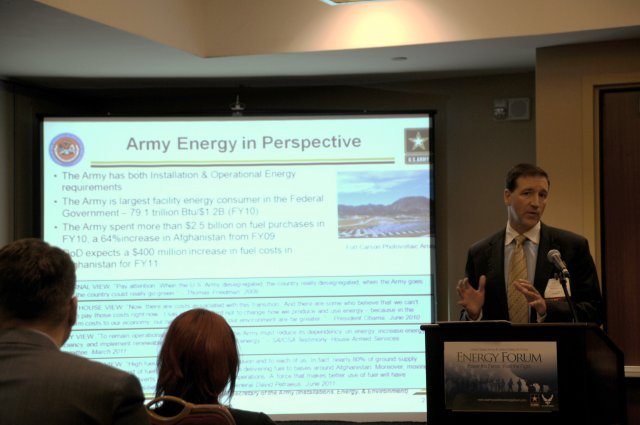The Base Realignment and Closure process will help the Army conserve energy, said Richard Kidd, deputy assistant secretary of the Army for Energy and Sustainability.
BRAC, set to be completed in September, is enabling the Army to reshape its infrastructure to support its forces by consolidating schools, bases and headquarters into more efficient and cost-controlled centers, Kidd told those attending the first Army – Air Force Energy Forum July 19 in Arlington, Va.
During the panel discussion titled “Energy in DOD,” Kidd explained the efforts that the Army was making toward energy sustainability.
While the Navy and Air Force consume more liquid forms of fuel, Kidd said that the Army is the largest consumer of facility energy in the Department of Defense and the entire federal government.
Last year, however, the Army’s fuel cost in Afghanistan rose 64 percent, he said.
“Our fuel costs are rising and they are volatile and they are unpredictable. They disrupt our budgets, our operational planning, and we’ve got to take steps to get them under control,” said Kidd.
The Army has taken several strides to initiate its goal of energy sustainability.
“First we change behavior,” said Kidd, “that’s the highest return on investment — is to change behavior so that your decisions are made in a way that values energy.”
One step the Army has implemented is the Net Zero plan, which aims to tackle problems with energy, water and waste control.
The Net Zero goal for energy is to produce as much energy as the installation uses. As for water, the goal is to be able to capture, reuse and release the same amount of water equal or greater than that which was taken initially. The focus on waste is to reduce the amount as much as possible through reuse and recycling.
Seventeen Net Zero installations are participating in the pilot program, along with a state-wide program for the Oregon Army National Guard.
“We think with our current technologies, we might be able to get 30-60 percent savings in fuel consumed in our base camps overseas,” said Kidd. “That could total up to 10-15 percent of our fuels in Afghanistan and that is a big difference.”
While developing these new technologies, the Army has also opened a Systems Integration Lab at Fort Devens, Mass., in order to test and compare two bases — one shadowing traditional bases, and the second implementing the new technologies.
Kidd explained that the second base will allow the Army to integrate and test renewable energy sources, efficiencies, microgrids, and other ways to push toward that 60 percent.
The largest component of energy consumption for the Army during wartime is electrical generators and Kidd said the Army plans to save $229 billion by removing spot generators and replacing them with more efficient generators.
“That is what we are going to save,” said Kidd, “simply by removing inefficient and undersized generators.”










